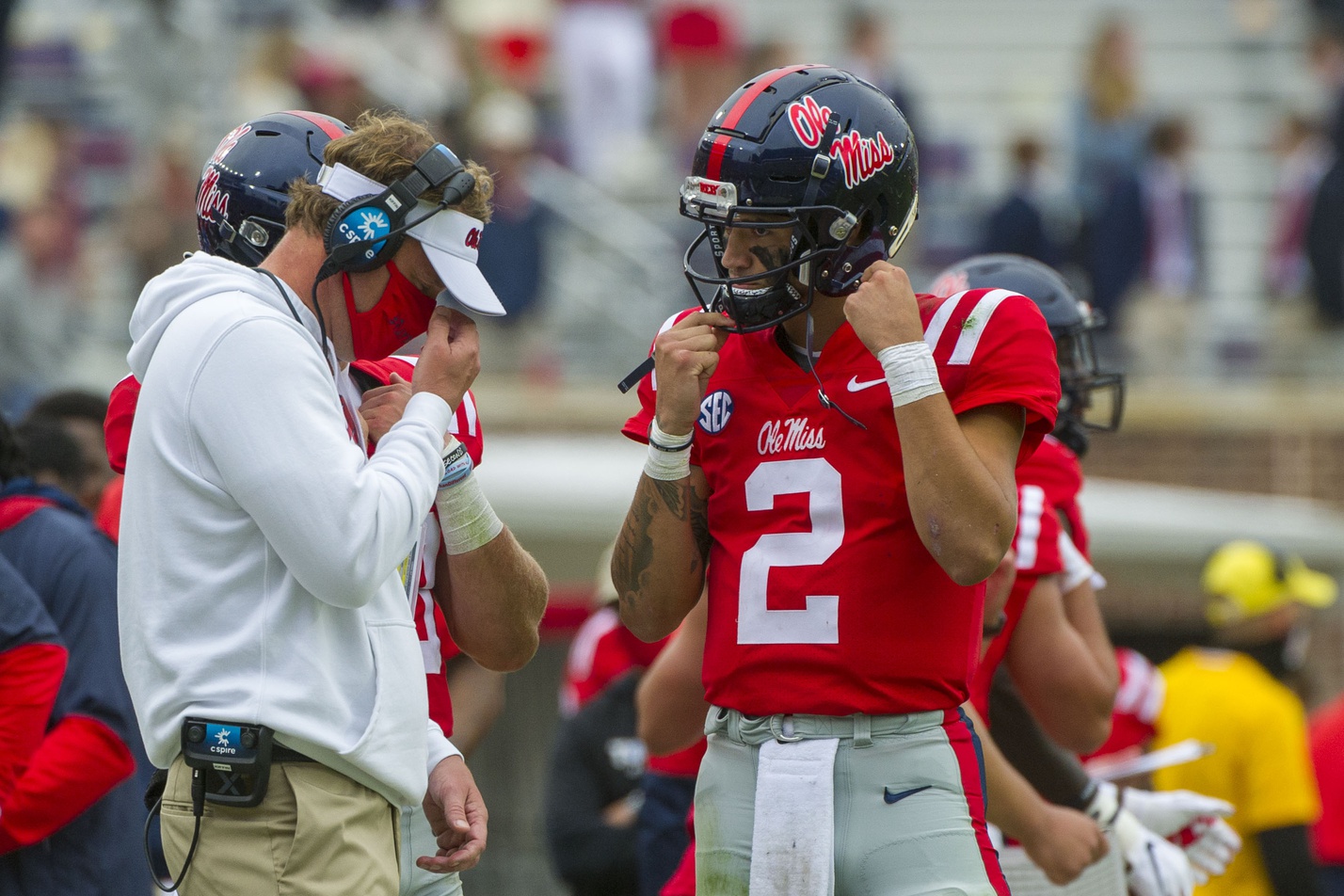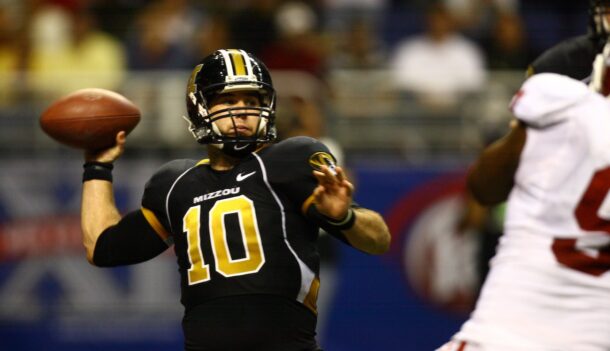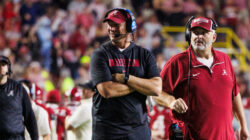
Let’s get offensive.
The SEC is coming off a year in which Alabama had the best Power 5 offense by 5 points, and it produced 2 Heisman Trophy finalists, along with first wide receiver to win the award in the 21st century. If an SEC team produces anything like that in 2021, it’d be a surprise. Then again, that’s what we said after LSU’s 2019 season, and Alabama did just about everything possible to replicate that.
Consider that one of the many questions worth asking about SEC offenses in 2021. Today, the focus is on a macro-level. These are league-wide questions, not team specific.
There will be plenty of time to ask questions like, “what will Florida’s run-pass splits look like?” Or “is KJ Jefferson an ideal fit in Kendal Briles’ offense?”
For now, these are the 10 league-wide questions I have about SEC offenses in 2021:
1. Will coordinator/QB continuity matter?
Only 4 SEC teams (Georgia, Mizzou, MSU and Ole Miss) can return the same starting quarterback and play-caller. That means 10 SEC programs — 11 if Jack Abraham wins the starting gig at MSU — will have a significant adjustment to make on offense. As we know in the 2020s, offense is king. You’re not winning the SEC by averaging 28 points a game.
It’s not a coincidence that JT Daniels and Matt Corral are getting the most early love for the preseason first-team All-SEC quarterback slot. They have talented skill players to work with and they showed tremendous upside in their respective offenses. Last year, I’d argue, coordinator/QB continuity did matter. Kyle Trask thrived with Dan Mullen and Mac Jones thrived with Steve Sarkisian. Shoot, Kellen Mond had his best season with Jimbo Fisher.
Will that change in 2021 after a relatively normal offseason that didn’t feature a mid-spring shutdown? Perhaps. Or maybe we’ll be reminded of how beneficial it can be to stay and develop within a specific system.
2. Will any team dare roll out the 2-quarterback system?
Man, I hope not.
The programs in the Volunteer State feel like the best bet to do so. Josh Heupel’s quarterback room has 4 possible options with Joe Milton now on board, and we know that there’s plenty of motivation to establish a legitimate attack in Year 1. It wouldn’t be a surprise to see Virginia Tech transfer Hendon Hooker and second-year signal-caller Harrison Bailey split some reps.
Vanderbilt is another candidate to use the 2-quarterback system. Ken Seals is the returning starter, but Michael Wright might be too good of a playmaker not to earn a serious look, at least early in the season. With Joey Lynch and David Raih now running that offense, nothing is guaranteed to Seals, who showed flashes but was understandably inconsistent as a true freshman last year.
I’d doubt we see Mike Leach use a 2-quarterback system by design, and I don’t think Mike Bobo and Bryan Harsin would prefer to do that, either. Florida, however, will use its variation of a 2-quarterback system with Emory Jones and Anthony Richardson. Then again, if it’s what we saw last year with Trask and Jones, would we really count that as a 2-quarterback system? I don’t think so.
Fingers crossed that nobody thinks splitting reps is a viable long-term option.
3. Will any true freshmen be QB1 from the jump?
I’d put my chips on “no.” Kaidon Salter was kicked off the team at Tennessee, Sawyer Robertson was a summer enrollee at MSU and Brock Vandagriff is clearly behind Daniels and Carson Beck at Georgia. The TJ Finley addition suggests Auburn didn’t want to turn to true freshman Dematrius Davis as Bo Nix’s backup, much less as QB1 from the jump.
Other than that? It doesn’t feel like that would happen unless we got an injury. It’s hard to envision guys like Jalen Milroe, Eli Stowers and Garrett Nussmeier starting for likely preseason top-15 teams when all of them, like Vandagriff, seem more like QB3 than QB2.
One caveat is the now-favorable path for quarterbacks to transfer anywhere and not lose a year of eligibility. If someone like Brennan were to leave LSU in August, that would at least open the door for a true freshman to earn that opportunity. Until then, though, don’t bank on a scenario like 2019, when Nix started from Day 1.
4. How will the SEC’s 3 best offensive linemen transition to left tackle?
Heading into the season, Darian Kinnard, Evan Neal and Kenyon Green are those guys. If you’re asking me to pick 1 SEC offensive lineman to build my dream 2021 team around, I’m picking from that group and feeling good about it.
What I’m not feeling quite as good about is the fact that all 3 are switching to left tackle. I’m seeing all 3 of those draft-eligible players show up in way-too-early mocks or preseason All-American teams when I’m still waiting to see how they function in their new roles.
Kinnard is a dominant run-blocker. Pro Football Focus had him as the highest-graded zone run-blocker of all tackles since 2019. How will he handle playing a new position and doing so in an offense that’ll have much more run-pass balance than Eddie Gran’s run-heavy system? That remains to be seen for Kinnard, who was a solid, but not elite pass-blocker at right tackle.
Green worries me a bit in part because he’s the only returning starter among A&M’s Maroon Goons. He didn’t look particularly dominant at left tackle in the spring game, though I don’t want to read too much into that. What I can’t ignore is that while Green is a former 5-star guy who excelled last season, he did so in a group surrounded by established veterans who also stayed healthy. I’ve seen Green slotted as a preseason third-team All-SEC selection (PFF) and as a top-5 pick (The Athletic) in way-too-early mock drafts. Where he ends up is anyone’s guess.
Speaking of former 5-star guys being slotted as potential top-5 picks, Neal is taking over for Alex Leatherwood, who once made the mid-college switch to left tackle himself. Neal was at right tackle, and like Kinnard, he thrived as a run-blocker. In that department, Neal was just outside of PFF’s top 10 among tackles. But now, he’ll be asked to be an elite pass blocker for a first-time starter in Bryce Young.
All of these guys will be playing a new, pressure-packed position with new quarterbacks behind them. Don’t assume it’ll be nothing but smooth sailing.
5. Can Kayshon Boutte and John Metchie really be the next guys up?
If those guys had a nickel for every time they heard that in the last 6 months, I bet they’d be as rich as their former receiver teammates who are cashing those NFL checks. Well, technically Boutte didn’t play in any games with Justin Jefferson or Ja’Marr Chase, but you get the picture. Metchie played in plenty of games with Jaylen Waddle and DeVonta Smith. Those guys could take over against elite defenses and put the offense on their back.
We saw Boutte do that down the stretch last year once Terrace Marshall opted out. But it’s a different story to do that for an entire season when you’re now seeing nothing but top corners. The question for Boutte and Metchie is if they can handle that. Both would love it if another guy could step up to take away some of that bracket coverage. If not, though, will they consistently get separation at an elite level?
More than if Boutte can be Chase or if Metchie can be Smith, that’s what’ll determine if they can become prolific, go-to receivers in 2021.
6. How hotly contested will the race for first-team All-SEC RB be?
I’ve already dubbed 2021 “return of the back.” Nine of PFF’s 10 highest-graded SEC running backs are returning (Najee Harris being the lone departure).
If you’re vying for first-team All-SEC running back honors, get in line. It’s a line that rolls 7-deep. Easily. Tank Bigsby, Kevin Harris, Isaiah Spiller, Chris Rodriguez, Jerrion Ealy, Zamir White and Brian Robinson all have a case to be made for preseason first-team All-SEC. That’s not including potential breakout guys like Devon Achane, James Cook, Kavosiey Smoke, Trelon Smith and others.
It wouldn’t surprise me if we saw perhaps 8 guys have 1,000-yard seasons. That would be 1 short of 2015, when the SEC produced nine 1,000-yard backs, 3 of which hit 1,500 yards and 20 touchdowns. The 2021 group probably won’t match that because running back volume is different now than it was 6 years ago, but after a 2-year stretch in which it was seemingly all about the passing, it feels like we’re going to get a resurgence from the SEC backs.
7. Who will be the league’s best hybrid weapon?
Let’s continue on that theme of running backs. Between Cook, Tyler Badie, Wan’Dale Robinson and Ainias Smith, there are some versatile weapons who are going to give SEC defenses all sorts of problems this year. Magnolia State playmakers Ealy and Jo’quavious Marks are worth mentioning here, too.
Whether that’s making catches out of the slot, burning linebackers on routes out of the backfield or occasionally lining up and running like a tailback between the tackles, it seems like there are no shortage of established all-purpose guys in the SEC in 2021.
That’s exciting, and it shows how the league has modernized its approach in recent memory.
My guess is that Ealy is going to earn the “AP” slot in the preseason, but that Robinson will earn it by season’s end playing in Liam Coen’s new offense at Kentucky. Like with the All-SEC running back slot, it should hotly contested.
8. Is any SEC tight end even going to sniff a Kyle Pitts comparison?
I love Jalen Wydermyer. Let the record show that I banged the drum for him to be first-team All-American to start the year. The A&M tight end’s catch radius, versatility and durability are that good. If you’re still sleeping on him, you shouldn’t be.
But it’s unfair to say that he or anyone will match the per-game production of Pitts’ 2020 season. That’s an outlier season that should almost be forgotten about. And the crazy thing is, the SEC actually has some strong options at tight end. Besides Wydermyer, Nick Muse is due for an uptick in South Carolina’s new offense, as is Jahleel Billingsley in Bill O’Brien’s tight end-friendly offense at Alabama. Of course, 5-star sophomore Darnell Washington lit up spring and could have a breakout season if Georgia’s offense decides to actually feature the tight end (remember Arik Gilbert is playing receiver at UGA).
Still, though. Are we really about to see an SEC tight end average nearly 100 receiving yards and 1.5 touchdown grabs per game like Pitts did? I doubt it.
Friends don’t let friends make lazy comparisons to the 2020 version of Pitts.
9. Which SEC play-caller is going to get a head coaching gig at season’s end?
I don’t think we’ll see a Steve Sarkisian-to-Texas type of move, but recent history suggests that we’re going to see at least 1 SEC offensive coordinator get that head coaching gig at season’s end. Maybe Sarkisian’s replacement, Bill O’Brien, will be 1-and-done. He had 2 years turning around Penn State in the post-Joe Paterno era, and as we’ve seen, Alabama offensive coordinators almost always go on to bigger and better things, no matter what stage they’re at in their careers.
If Todd Monken is the offensive coordinator who leads Georgia to a national title, you can bet he’ll have plenty of those opportunities coming his way. Jeff Lebby is the most obvious choice here after he was reportedly one of the finalists to get the UCF gig. Another season lighting up SEC scoreboards with Lane Kiffin, and we could easily see that happen.
Some of the off-the-radar guys would be Jake Peetz at LSU and Liam Coen at Kentucky. You don’t have to be Joe Brady 2.0 to become 1-year wonders. You’ll notice that 4 of those 5 play-callers work alongside defensive-minded SEC head coaches (10 of the SEC’s 14 head coaches now have an offensive background). They have autonomy on the offensive side of the ball.
Or maybe none of those guys will get head coaching gigs and instead it’ll be either an offensive position coach like LSU receivers coach Mickey Joseph or a defensive coordinator like A&M’s Mike Elko or MSU’s Zach Arnett.
Of that group, though, give me Lebby to take the next step after 2021.
10. Who will have the SEC’s best offense?
These past 3 seasons all had historically dominant offenses lead the way. Alabama had the SEC’s best group in 2018 and 2020, and of course, LSU had 2019. Will this be the 4th consecutive year in which an SEC offense averaged north of 45 points per game? It’s certainly possible.
Last year’s Alabama offense was supposed to take a step back with Mac Jones and it instead delivered the most prolific unit in program history. Here’s the thing, though. Besides losing Sarkisian and having a new play-caller, Alabama had 9 (!) offensive players selected in Round 1 in the past 2 drafts. Are the Tide really about to improve yet again? I wouldn’t bank on it, though this year’s group with Young could take a slight step back and still have the SEC’s best group.
Florida and Ole Miss finished just shy of 40 points per contest last year. Given what each returns on offense, the odds favor Ole Miss being more likely to improve. If Dan Mullen’s offense improves after losing Trask, Pitts, Kadarius Toney and Trevon Grimes, he’ll have National Coach of the Year buzz. If Kiffin’s offense improves, nobody will be surprised.
There’s a case to be made that the Ole Miss offense might not have to score 40 every week with a slightly improved defense, though there shouldn’t be some identity shift in Oxford. As long as Corral can stay healthy, putting up the SEC’s best offense is on the table.
Georgia hasn’t had the SEC’s No. 1 offense since 2014, though that team had a much different identity with Todd Gurley (half a season) and Nick Chubb. There’s depth and talent in the 2021 Georgia backfield, but everyone wants to know the same thing. Can this year’s high-flying passing attack fuel a historic offense? I’d say even without George Pickens for at least part of the season, Georgia is as good of a candidate as anyone to do that. It’ll depend on Arik Gilbert developing as a true outside receiver and Daniels progressing in the intermediate passing game.
The battle for “SEC’s best offense” could easily be 4-5 deep. Maybe even a team like A&M or LSU could be in the mix by season’s end.
One thing I do know about SEC offenses? Scoring won’t be lacking in 2021.
Connor O'Gara is the senior national columnist for Saturday Down South. He's a member of the Football Writers Association of America. After spending his entire life living in B1G country, he moved to the South in 2015.







